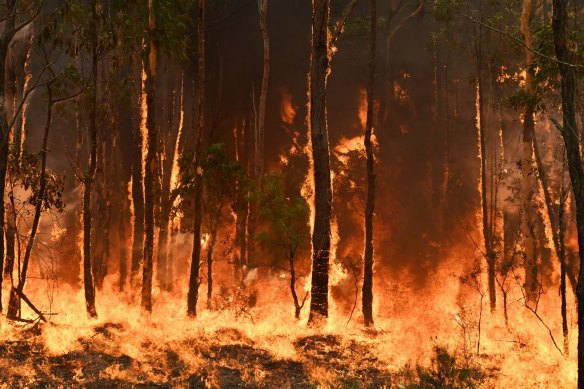Proactive Building Defense: Leveraging the Insights of a BAL Report
Proactive Building Defense: Leveraging the Insights of a BAL Report
Blog Article
Ensuring Shrub Fire Protection Via Appropriate BAL Record Evaluation
In the world of bush fire defense, the precise evaluation of Bushfire Attack Level (BAL) records stands as a cornerstone for guarding properties against the devastating effect of wildfires. With ecological factors and residential property attributes playing considerable duties in identifying the degree of threat, a thorough understanding of BAL scores comes to be vital.
Recognizing Bushfire Attack Level (BAL)
In the realm of bushfire protection, comprehending the Bushfire Assault Degree (BAL) is extremely important for guaranteeing efficient reduction approaches. BAL is a system used to measure the prospective danger a structure might encounter from a bushfire. It takes into consideration factors such as the kind of greenery, the slope of the land, the Fire Risk Index, and the Fire Intensity Index. Recognizing the BAL ranking of a home is critical for residential or commercial property owners, home builders, and policymakers to apply ideal measures to protect versus bushfire hazards.

Importance of BAL Report Evaluation
A vital element in bushfire security planning involves the extensive evaluation of BAL reports to evaluate the potential risks and identify appropriate mitigation techniques. BAL reports provide important info regarding the prospective impact of bushfires on a residential property based on different aspects such as plants type, distance to potential fire threats, and slope of the land. Evaluating these records with accuracy is critical in creating efficient bushfire protection actions customized to the specific threat profile of a home.
Implementing Fire Defense Procedures
Executing reliable fire protection measures is crucial for safeguarding residential properties in bushfire-prone locations. This involves clearing flammable greenery, such as dry fallen leaves and branches, within a particular distance of the residential or commercial property.
Furthermore, having a well-maintained and adequate supply of water, such as a storage tank or pool, can assist firefighters in their efforts to safeguard the residential property. It is vital to have a clear discharge plan in location and to make certain that all locals recognize with the procedures. Additionally, having firefighting tools easily available, such as pipes and fire extinguishers, can assist in tackling little area fires before they intensify. On the whole, applying a mix of these fire defense actions can significantly increase the opportunities of guarding homes during bushfire events.
Mitigating Dangers in Fire-Prone Areas
To strengthen homes versus bushfire dangers, a tactical focus on mitigating threats in fire-prone areas is vital. Mitigating threats in More hints fire-prone areas entails an extensive strategy that includes various measures to minimize the likelihood and influence of bushfires. One essential facet of risk mitigation is maintaining defensible area around homes by getting rid of flammable plant life, guaranteeing ample spacing between frameworks and trees, and employing fireproof landscape design practices. Furthermore, implementing ember-proofing steps such as mounting try this out steel mesh screens on home windows and covering roofing system tooth cavities can assist protect against coal strikes and decrease the risk of spot fires.
Furthermore, constructing or retrofitting buildings with fire-resistant materials and making sure appropriate upkeep of roof coverings, seamless gutters, and exterior cladding can substantially enhance the building's strength to bushfires. Exercising a bushfire and developing emergency situation strategy with all owners, consisting of evacuation treatments and interaction strategies, is likewise vital in mitigating threats efficiently. By adopting a positive method to take the chance of mitigation in fire-prone locations, homeowner can much better secure their possessions and improve overall bushfire readiness.
Ensuring Home Safety and Resilience
Ensuring the safety and security and resilience of residential or commercial properties in fire-prone locations requires a steadfast commitment to durable safety nets and strategic preparation. Building safety and security starts with implementing effective actions to reduce fire hazards. This includes preserving a defensible room around the residential property by removing flammable vegetation, guaranteeing correct upkeep of seamless gutters and roofs, and using fire-resistant building products. Normal upkeep of firefighting equipment, such as hoses and lawn sprinkler, is additionally critical to residential or commercial property strength.
Resilience, on the other hand, entails the capacity of a building to recover and withstand from a bushfire. By proactively resolving these facets, residential property owners can better shield their possessions and enjoyed ones from the threat of bushfires.
Final Thought
To conclude, making sure bushfire protection with correct BAL record analysis is vital for understanding the level of threat posed by bushfires and carrying out essential fire protection steps. By minimizing risks in fire-prone areas and making sure residential or commercial property security and strength, individuals and neighborhoods can better plan for and react to bushfire events. It is necessary to prioritize fire security measures to safeguard lives and property in these high-risk atmospheres.
In the world of bush fire defense, the precise analysis of Bushfire Assault Degree (BAL) records stands as a keystone for safeguarding residential properties versus the terrible effect of wildfires (BAL Report). Recognizing the BAL rating of a home is vital for residential or commercial property resource policymakers, owners, and builders to apply proper steps to protect against bushfire hazards

BAL records offer essential info about the prospective influence of bushfires on a property based on various factors such as greenery kind, range to potential fire risks, and slope of the land (BAL Report). In general, carrying out a mix of these fire defense actions can significantly increase the chances of protecting residential properties throughout bushfire occasions
Report this page